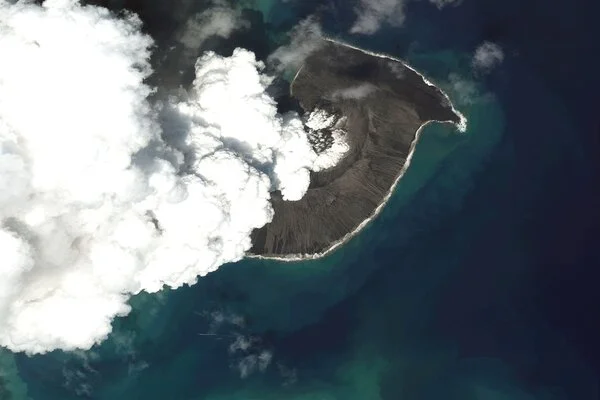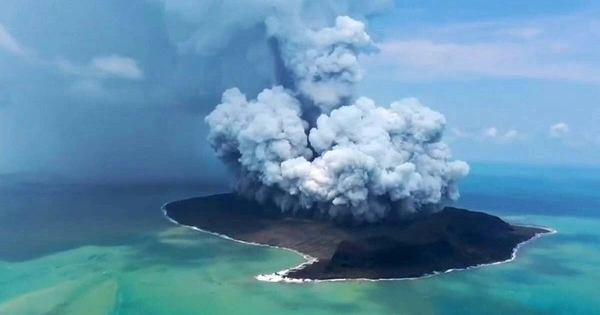The undersea volcanic eruption at Hunga Tonga was one of the most powerful ever recorded, with audible sound detected more than 10,000 kilometers away. A research group at Nagoya University in Japan used data from the eruption of the underwater volcano near Tonga in 2022 to track the airwaves that cause the tsunami. Their discoveries could lead to more accurate predictions of these massive waves.
When it comes to warning people in the path of a tsunami, every minute counts. A tsunami in Indonesia reached Sri Lanka in less than two hours after the 2004 Indian Ocean earthquake. It arrived on the coast of Kenya eight hours later. If there had been a way to notify people about the dangers of a tsunami in those faraway areas, it may have been possible to save at least some of the 230,000 victims.
On 20 December 2021, an eruption began on Hunga Tonga–Hunga Ha’apai, a submarine volcano in the Tongan archipelago in the southern Pacific Ocean. The eruption reached a very large and powerful climax nearly four weeks later, on 15 January 2022. Hunga Tonga–Hunga Haʻapai is 65 km (40 mi) north of Tongatapu, the country’s main island, and is part of the highly active Tonga–Kermadec Islands volcanic arc, a subduction zone extending from New Zealand’s north-northeast to Fiji. In the Volcanic Explosivity Index scale, the eruption was rated at least a VEI-5.
We captured the signal of the ionospheric disturbance caused by the air pressure wave about three hours before the pressure wave originating from the volcanic eruption believed to have triggered the tsunami in Japan.
Atsuki Shinbori
A research team led by Assistant Professor Atsuki Shinbori, Associate Professor Yuichi Otsuka, and Associate Professor Nozomu Nishitani of Nagoya University’s Institute for Space-Earth Environmental Research (ISEE), in collaboration with the National Institute of Information and Communications Technology and the University of Electro-Communications, believes it may be possible to predict tsunami faster by tracking atmospheric disturbances caused by air waving. Their findings were published in the journal Earth, Planets, and Space.
When a tsunami occurs, it deforms the lower atmosphere and generates oscillations of sound and gravity waves, causing disturbances of electrons in the upper atmosphere, also known as the ionosphere. Radio waves, such as those used in GPS and satellite broadcasting/communications, also pass through this region of the atmosphere. As a result, natural disasters cause errors in the positional information provided by GPS satellites.

Shinbori and his group used satellites and radar to examine these errors following the 2022 undersea volcanic eruption off the coast of Tonga in the South Pacific. They found that the eruption of the underwater volcano caused waves of air pressure that spread as far as Australia and Japan. These waves oscillated the lower part of the ionosphere. This generated an electric field that was then transmitted at high speed to the upper ionosphere. To their surprise, the researchers detected the electron changes much earlier than the air pressure waves that caused the tsunami.
Surprisingly, the structures of the disturbance over Japan and Australia mirrored each other. Despite being in different hemispheres, they happened almost simultaneously because they disturbed electrons in magnetic field lines, which radiate from the south magnetic pole to the north magnetic pole. The researchers calculated the speed of these disturbances and discovered that the electromagnetic wave along the magnetic field lines moved at 1000 kilometers (621.4 miles) per second. This was much faster than the air pressure wave, which moved at the speed of sound (315 meters (0.2 miles) per second).
“We captured the signal of the ionospheric disturbance caused by the air pressure wave about three hours before the pressure wave originating from the volcanic eruption believed to have triggered the tsunami in Japan,” Shinbori explains. “In short, the significance of these results can be divided into two aspects: the scientific aspect of a coupled system, and the disaster prevention aspect of preparedness for severe events such as tsunamis.”
The technique’s future applications are already being considered. “Statistical analysis of ionospheric disturbances during volcanic eruptions and seismic events may allow us to estimate tsunami wave heights and sizes in the future,” Shinbori says. “Ionospheric disturbances could represent a new step forward in tsunami warnings.”





